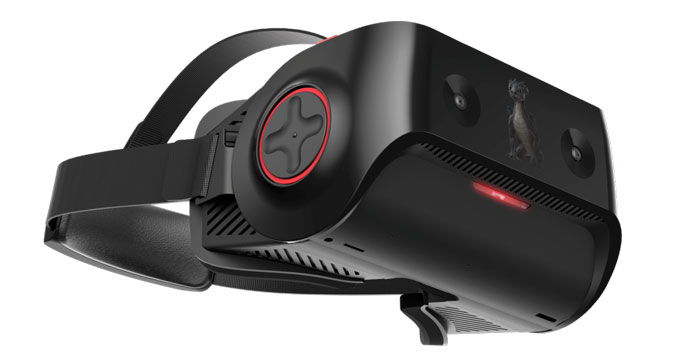 NEWS
NEWS
 NEWS
NEWS
 NEWS
NEWS
Telecommunications chip maker Qualcomm Technologies Inc. announced yesterday its ambitious specification for a powerful, standalone virtual reality (VR) headset called the Snapdragon VR280. The headset will be built on Qualcomm’s 820 mobile processor and software development kit (SDK) designed to work with modern VR software. The hardware is being developed in collaboration with Chinese electronics company Goertek.
“Consumers everywhere are captivated by truly immersive VR experiences, and Qualcomm Technologies’ capabilities in graphics, displays, video, audio, computer vision and sensor technologies, as well as power and thermal efficiencies proven over years of smartphone innovation, uniquely positions us to help customers bring these experiences to life,” said Anthony Murray, senior vice president and general manager, IoT, Qualcomm Technologies International, Ltd.
The International Data Corporation (IDC) predicts that the VR and augmented reality (AR) industry (hardware, software and entertainment) will be a $162 billion market within four years. It is also believed that mobile VR will provide the bulk of the market before PC-based VR gains significant traction and this Qualcomm headset sits between both worlds (especially if it can be slaved to a PC). In November, 2015 Oculus Inc. co-founder Palmer Luckey said he believed that bulky wires connecting VR headsets to PC’s would retard that industry segment’s growth.
“The Snapdragon VR820 integrates key technologies and features for an exceptional VR experience,” Murray added, “and provides a springboard for OEMs and developers to usher in the next generation of truly portable and untethered devices that we think are necessary for mass consumer adoption of VR.”
The reference headset is supposed to be available sometime by the end of 2016—with no price tag set by Qualcomm yet—and the company expects that commercial devices based on the reference will follow shortly.
The Snapdragon VR280 is a fully enclosed, all-in-one wireless Android-powered headset designed to provide self-contained VR output for a user. It will feature 1440 x 1440 for each eye (which is higher than the Oculus Rift and HTC Vive which feature only 1080 x 1200 per eye), although its refresh rate will be 70Hz (compared to 90Hz for the Rift and Vive).
The device will supply console-quality, next-generation VR gaming and apps with its powerful Qualcomm Adreno 530 GPU. As mentioned above, it can drive 1440 x 1440 resolution per eye with AMOLED that supports 70Hz refresh. Sound for the device will be delivered with stereo, binaural audio and 3D surround sound coupled with four microphones for HD noise filtering and active noise cancellation.
The headset will also feature cameras for eye-tracking and hand gesture recognition. To provide powerful interactive capabilities the device will use dual front-facing cameras for six degrees of freedom (6DOF) and see-through applications, a gyro, accelerometer and magnetometer sensors built in for finer movement tracking.
A standalone VR headset already exists on the market called the Pico Neo. Also powered by the Snapdragon 820 chip reference, it can provide high-quality 3D graphics and 360-degree HVEC video. However, it uses its own controller to house its powerful processor and battery and, as Engadget put it, “This is a good idea, even if you probably shouldn’t buy it.”
Image credit: Courtesy of Qualcomm, Inc.
As part of the announcement for the Snapdragon VR280, Qualcomm announced a software development kit for the Snapdragon 820 processor series. The SDK is designed to provide a reference set of instructions and methods for developers to use to attach and command libraries for developing VR experiences using these processors, which will be featured in upcoming Android smartphones and VR headsets.
The SDK will include methods for accessing and taking advantage of sensors for more responsive and immersive experiences using higher polling rates from inertial data and gyroscopes and accelerometers via the “Snapdragon Sensor Core” and “predictive head position processing with the Qualcomm® Hexagon DSP.”
The processor also supports a 50 percent latency reduction for fast transformation of objects/images rendered in the 3D space using asynchronous time-warp with single-buffer rendering, which cannot be achieved without the SDK.
To help developers with user interface (UI) development, the SDK also includes libraries for VR layering of menus, text and other overlays such that they can be properly rendered and positioned in the VR visible world in relation to the viewer.
Finally, the Qualcomm Symphony System Manger SDK is available to provide cohesive CPU, GPU and DSP power and performance management to help achieve stable frame rates for low-power, thermally-constrained devices (such as smartphones).
Already improving on VR-enabled chips, Qualcomm doesn’t slow down with the 821.
While the Snapdragon VR820 may be based on the Snapdragon 820 processor, developers may be looking forward to the processor next-in-line with the Snapdragon 821 processor announced recently by Qualcomm. While the reference spec includes the 820, with the launch of the 821 it’s most likely that will become the go-to processor for VR platforms.
According to The Verge, the Snapdragon 821 will be Google Daydream VR platform enabled (developer’s guide for Google Daydream available on SiliconANGLE). The chip will come with full support for the Snapdragon VR SDK (mentioned above) and will also reportedly have a five percent better battery life and five percent better GPU speed.
Support our mission to keep content open and free by engaging with theCUBE community. Join theCUBE’s Alumni Trust Network, where technology leaders connect, share intelligence and create opportunities.
Founded by tech visionaries John Furrier and Dave Vellante, SiliconANGLE Media has built a dynamic ecosystem of industry-leading digital media brands that reach 15+ million elite tech professionals. Our new proprietary theCUBE AI Video Cloud is breaking ground in audience interaction, leveraging theCUBEai.com neural network to help technology companies make data-driven decisions and stay at the forefront of industry conversations.